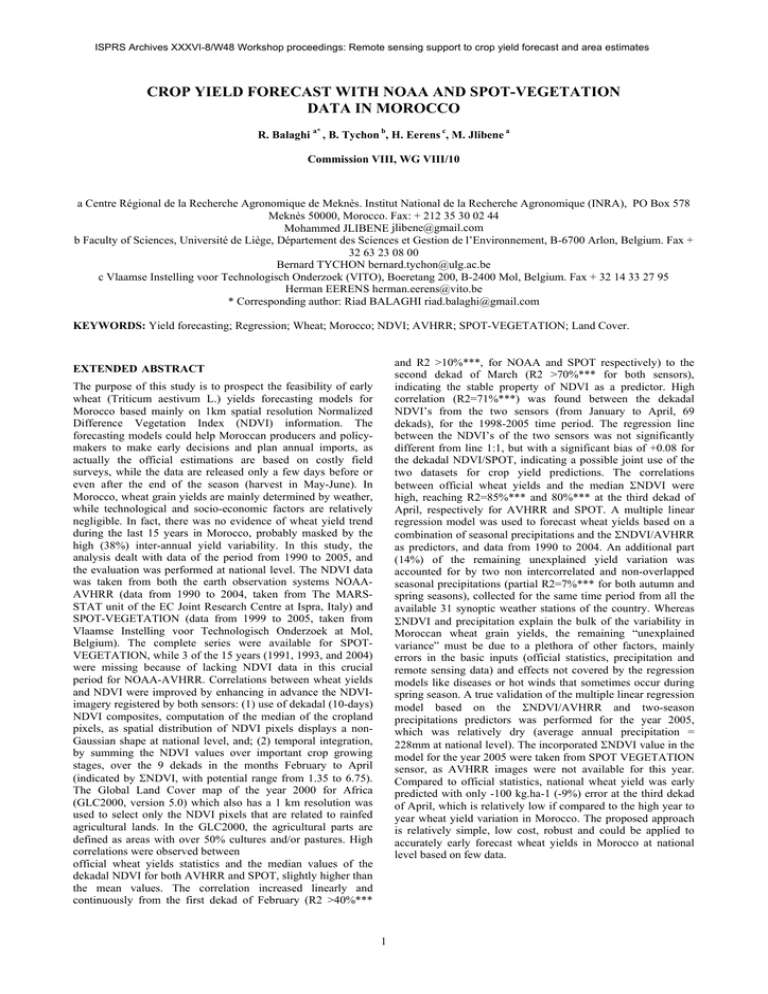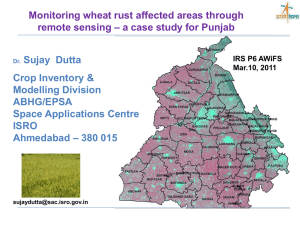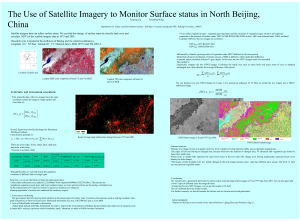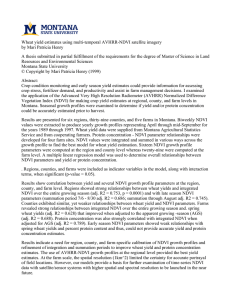Document 11869380
advertisement

ISPRS Archives XXXVI-8/W48 Workshop proceedings: Remote sensing support to crop yield forecast and area estimates CROP YIELD FORECAST WITH NOAA AND SPOT-VEGETATION DATA IN MOROCCO R. Balaghi a* , B. Tychon b, H. Eerens c, M. Jlibene a Commission VIII, WG VIII/10 a Centre Régional de la Recherche Agronomique de Meknès. Institut National de la Recherche Agronomique (INRA), PO Box 578 Meknès 50000, Morocco. Fax: + 212 35 30 02 44 Mohammed JLIBENE jlibene@gmail.com b Faculty of Sciences, Université de Liège, Département des Sciences et Gestion de l’Environnement, B-6700 Arlon, Belgium. Fax + 32 63 23 08 00 Bernard TYCHON bernard.tychon@ulg.ac.be c Vlaamse Instelling voor Technologisch Onderzoek (VITO), Boeretang 200, B-2400 Mol, Belgium. Fax + 32 14 33 27 95 Herman EERENS herman.eerens@vito.be * Corresponding author: Riad BALAGHI riad.balaghi@gmail.com KEYWORDS: Yield forecasting; Regression; Wheat; Morocco; NDVI; AVHRR; SPOT-VEGETATION; Land Cover. and R2 >10%***, for NOAA and SPOT respectively) to the second dekad of March (R2 >70%*** for both sensors), indicating the stable property of NDVI as a predictor. High correlation (R2=71%***) was found between the dekadal NDVI’s from the two sensors (from January to April, 69 dekads), for the 1998-2005 time period. The regression line between the NDVI’s of the two sensors was not significantly different from line 1:1, but with a significant bias of +0.08 for the dekadal NDVI/SPOT, indicating a possible joint use of the two datasets for crop yield predictions. The correlations between official wheat yields and the median ΣNDVI were high, reaching R2=85%*** and 80%*** at the third dekad of April, respectively for AVHRR and SPOT. A multiple linear regression model was used to forecast wheat yields based on a combination of seasonal precipitations and the ΣNDVI/AVHRR as predictors, and data from 1990 to 2004. An additional part (14%) of the remaining unexplained yield variation was accounted for by two non intercorrelated and non-overlapped seasonal precipitations (partial R2=7%*** for both autumn and spring seasons), collected for the same time period from all the available 31 synoptic weather stations of the country. Whereas ΣNDVI and precipitation explain the bulk of the variability in Moroccan wheat grain yields, the remaining “unexplained variance” must be due to a plethora of other factors, mainly errors in the basic inputs (official statistics, precipitation and remote sensing data) and effects not covered by the regression models like diseases or hot winds that sometimes occur during spring season. A true validation of the multiple linear regression model based on the ΣNDVI/AVHRR and two-season precipitations predictors was performed for the year 2005, which was relatively dry (average annual precipitation = 228mm at national level). The incorporated ΣNDVI value in the model for the year 2005 were taken from SPOT VEGETATION sensor, as AVHRR images were not available for this year. Compared to official statistics, national wheat yield was early predicted with only -100 kg.ha-1 (-9%) error at the third dekad of April, which is relatively low if compared to the high year to year wheat yield variation in Morocco. The proposed approach is relatively simple, low cost, robust and could be applied to accurately early forecast wheat yields in Morocco at national level based on few data. EXTENDED ABSTRACT The purpose of this study is to prospect the feasibility of early wheat (Triticum aestivum L.) yields forecasting models for Morocco based mainly on 1km spatial resolution Normalized Difference Vegetation Index (NDVI) information. The forecasting models could help Moroccan producers and policymakers to make early decisions and plan annual imports, as actually the official estimations are based on costly field surveys, while the data are released only a few days before or even after the end of the season (harvest in May-June). In Morocco, wheat grain yields are mainly determined by weather, while technological and socio-economic factors are relatively negligible. In fact, there was no evidence of wheat yield trend during the last 15 years in Morocco, probably masked by the high (38%) inter-annual yield variability. In this study, the analysis dealt with data of the period from 1990 to 2005, and the evaluation was performed at national level. The NDVI data was taken from both the earth observation systems NOAAAVHRR (data from 1990 to 2004, taken from The MARSSTAT unit of the EC Joint Research Centre at Ispra, Italy) and SPOT-VEGETATION (data from 1999 to 2005, taken from Vlaamse Instelling voor Technologisch Onderzoek at Mol, Belgium). The complete series were available for SPOTVEGETATION, while 3 of the 15 years (1991, 1993, and 2004) were missing because of lacking NDVI data in this crucial period for NOAA-AVHRR. Correlations between wheat yields and NDVI were improved by enhancing in advance the NDVIimagery registered by both sensors: (1) use of dekadal (10-days) NDVI composites, computation of the median of the cropland pixels, as spatial distribution of NDVI pixels displays a nonGaussian shape at national level, and; (2) temporal integration, by summing the NDVI values over important crop growing stages, over the 9 dekads in the months February to April (indicated by ΣNDVI, with potential range from 1.35 to 6.75). The Global Land Cover map of the year 2000 for Africa (GLC2000, version 5.0) which also has a 1 km resolution was used to select only the NDVI pixels that are related to rainfed agricultural lands. In the GLC2000, the agricultural parts are defined as areas with over 50% cultures and/or pastures. High correlations were observed between official wheat yields statistics and the median values of the dekadal NDVI for both AVHRR and SPOT, slightly higher than the mean values. The correlation increased linearly and continuously from the first dekad of February (R2 >40%*** 1 ISPRS Archives XXXVI-8/W48 Workshop proceedings: Remote sensing support to crop yield forecast and area estimates 2




